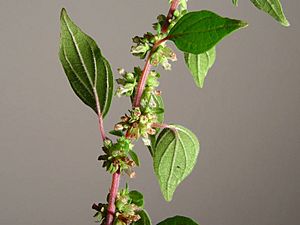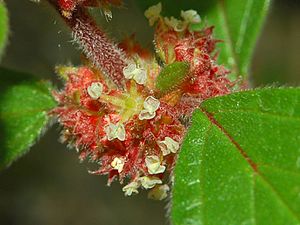Parietaria judaica facts for kids
Quick facts for kids Parietaria judaica |
|
|---|---|
 |
|
| Plants of Parietaria judaica | |
| Scientific classification | |
| Kingdom: | |
| (unranked): | |
| (unranked): | |
| (unranked): | |
| Order: | |
| Family: | |
| Genus: |
Parietaria
|
| Species: |
P. judaica
|
| Binomial name | |
| Parietaria judaica |
|
| Synonyms | |
|
|
Parietaria judaica, also known as spreading pellitory or pellitory of the wall, is a type of plant that lives for many years. It belongs to the nettle family, Urticaceae. The pollen from this plant can cause strong allergic reactions in some people. In Australia, it is often called "asthma weed" because it causes a lot of allergies there. This plant is not related to the herb pellitory (Anacyclus pyrethrum). It can also be easily confused with a very similar plant called Parietaria officinalis.
Contents
About the Name
What Parietaria Means
The name Parietaria comes from a Latin word. It means "wall-dweller." This name was first used by an ancient Roman writer and philosopher named Pliny.
What Judaica Means
The second part of the name, Judaica, also comes from Latin. It means "of Judaea" or "Jewish." This refers to the Palestine region where the plant is found.
What the Plant Looks Like
This plant grows from buds that are just below the soil surface. Its main stem usually grows straight up. Parietaria judaica has pink or red stems that feel hairy. The bottom part of the stem becomes woody. On average, this plant can grow up to about 60 centimeters (about 2 feet) tall.
The leaves are green and hairy. They grow one after another along the stem. The edges of the leaves are smooth. The flowers are very tiny and can be white or pink. They grow in clusters where the leaves meet the stem. Some flowers have both male and female parts, while others have only male or only female parts.
People sometimes call this plant "sticky-weed." This is because its flowers and hairy stems can stick to things. But unlike some other plants in the nettle family, its hairs do not sting you. This plant flowers from spring all the way through autumn. During this time, it produces a lot of pollen. The fruits of the plant are small, black seeds called achenes.
Where It Grows
Parietaria judaica is originally from Europe, central and western Asia, and northern Africa.
Allergies and Health
The pollen from Parietaria judaica can cause allergic reactions in some people. This means that if you are sensitive to it, you might experience symptoms like sneezing, a runny nose, itchy eyes, or even asthma.
Where It Lives
This plant is often seen as a weed. You can usually find it growing along roadsides, on old stone walls, and in cracks of buildings or rocks. However, it can also be helpful in a garden if it's native to your area. This is because it is a food source for the caterpillars of red admiral butterflies (Vanessa atalanta).
Parietaria judaica prefers dry places. It grows well at altitudes from sea level up to about 1,000 meters (about 3,300 feet) high. The plant's pollen is carried by the wind. Its seeds are sticky, which helps them to be carried by insects, other animals, people, and even machines.
Gallery
See also
 In Spanish: Parietaria judaica para niños
In Spanish: Parietaria judaica para niños






